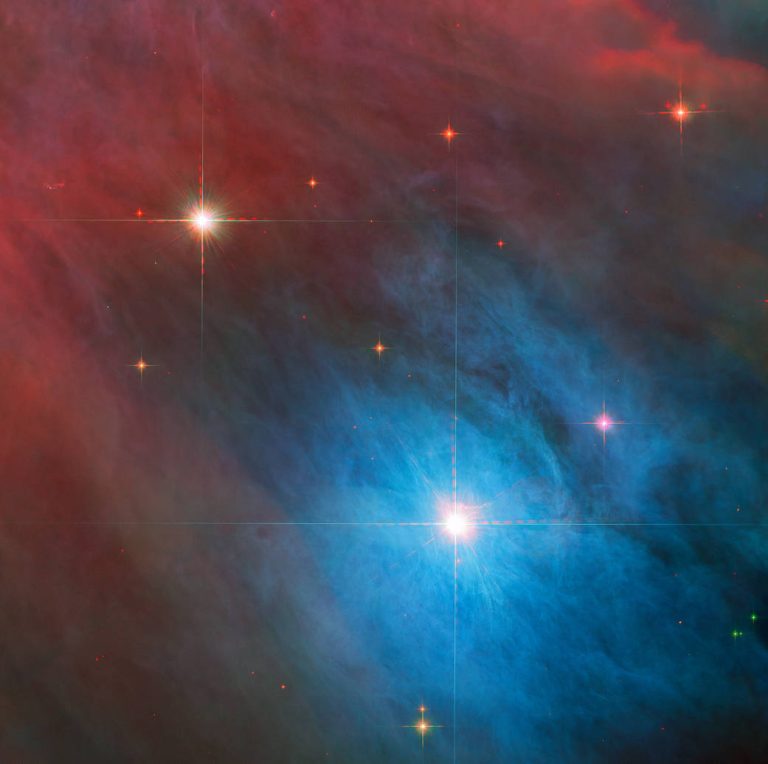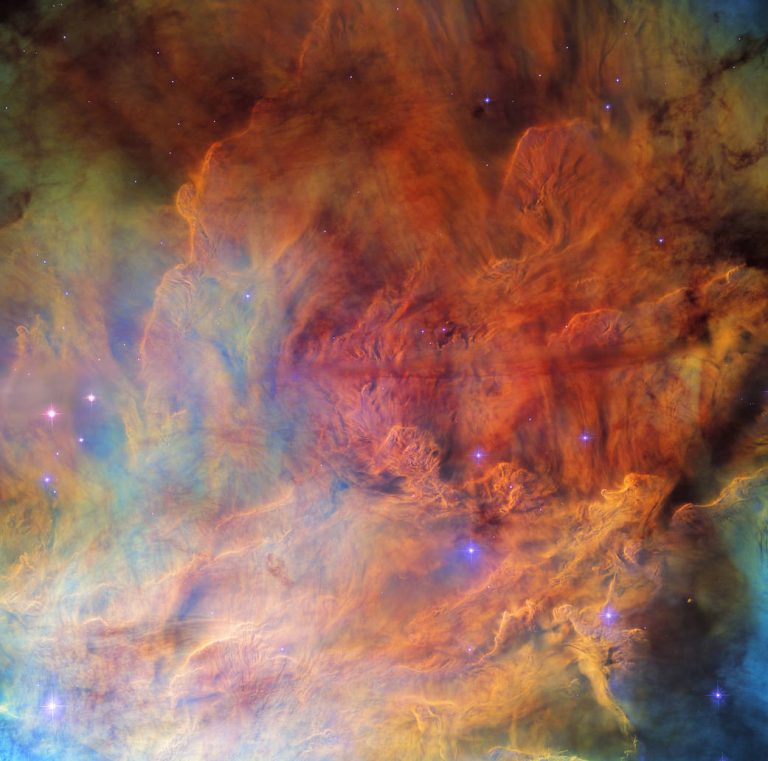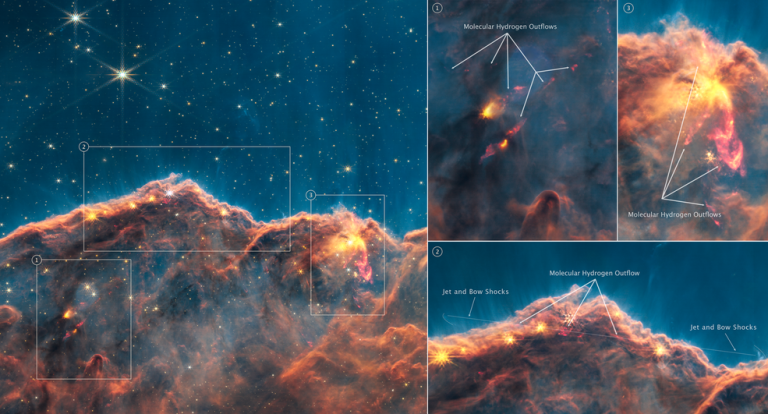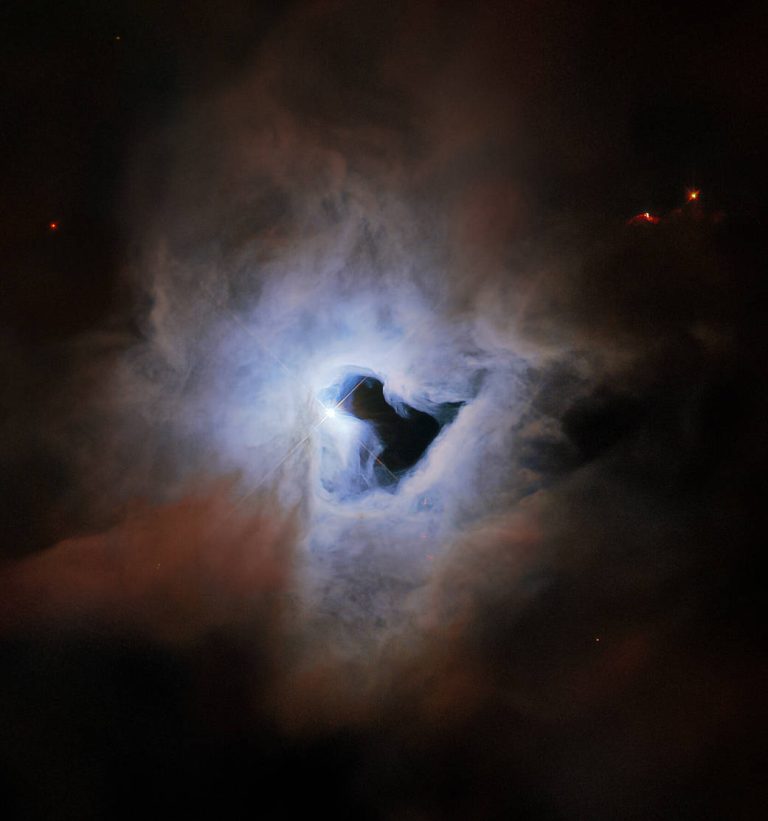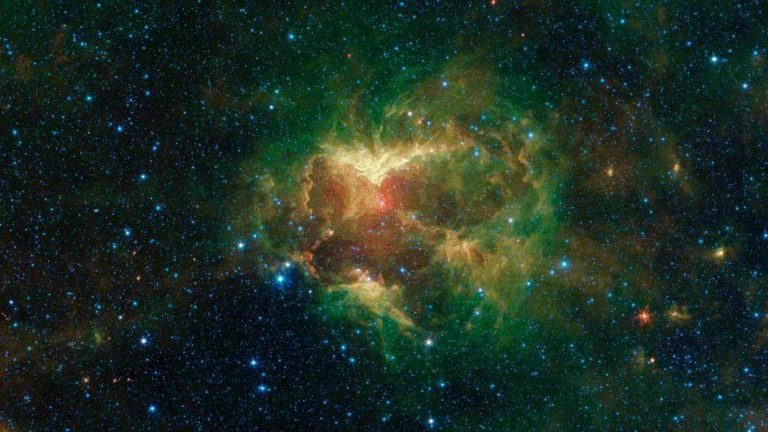在NASA詹姆斯·韦伯太空望远镜的近红外视图中,创生之柱呈现出万花筒般的色彩。这些柱子看起来像是从沙漠景观中升起的拱门和尖塔,但却充满了半透明的气体和尘埃,而且不断变化。这是一个年轻恒星正在形成的区域,或者说,在它们继续形成的过程中刚刚从它们的尘埃茧中破茧而出。 影像来源:NASA, ESA, CSA, STScI; Joseph DePasquale (STScI), Anton M. Koekemoer (STScI), Alyssa Pagan (STScI). NASA的詹姆斯·韦伯太空望远镜拍摄到了一幅郁郁葱葱、非常详细的景观——标志性的创生之柱,在那里,新的恒星正在稠密的气体云和尘埃云中形成。这些三维柱子看起来像雄伟的岩层,但渗透性更强。这些柱状物由冷的星际气体和尘埃组成,它们有时在近红外光下呈半透明。 1995年,NASA哈勃太空望远镜首次拍摄到创生之柱(Pillars of Creation)的图像,使之声名鹊起。韦伯对创生之柱的新观点将帮助研究人员通过更精确地确定新形成恒星的数量,以及该地区气体和尘埃的数量,来改进恒星形成模型。随着时间的推移,他们将开始更清楚地了解数百万年来恒星是如何从这些尘土飞扬的云层中形成和爆发。 1995年,NASA哈勃太空望远镜首次拍摄到创生之柱(Pillars of Creation)的图像,使之声名鹊起。2014年,哈勃望远镜重新拍摄了这一场景,在可见光下展现了更清晰、更广阔的视野,如上图左图所示。NASA詹姆斯·韦伯太空望远镜拍摄的一幅新的近红外光图(见右图),帮助我们看到了这个恒星形成区域更多的尘埃。厚厚的、灰蒙蒙的棕色恒星柱不再那么不透明,更多仍在形成的红色恒星出现在我们的视野中。 影像来源:NASA, ESA, CSA, STScI; Joseph DePasquale (STScI), Anton M. Koekemoer (STScI), Alyssa Pagan (STScI). 在这张韦伯近红外相机(NIRCam)拍摄的照片中,新形成的恒星最为抢眼。这些明亮的红色球体通常具有衍射尖峰,位于尘埃柱的外面。当气体和尘埃柱内形成具有足够质量的结节时,它们在自身重力作用下开始坍缩,缓慢升温,最终形成新恒星。 那些在尘埃柱边缘看起来像熔岩的波浪线呢?这些是恒星的抛射物,它们仍在气体和尘埃中形成。年轻的恒星会周期性地喷射出超音速喷流,这些喷流会与物质云发生碰撞,比如这些厚厚的尘埃柱。这有时也会导致弓形冲击,这种冲击可以形成波浪状的图案,就像船在水中移动一样。深红色的光芒来自喷流和冲击产生的高能氢分子。这在从顶部看的第二和第三根尘埃柱上很明显——NIRCam图像实际上随着它们的活动而跳动。据估计,这些年轻的恒星只有几十万年的历史。 尽管近红外光似乎使韦伯能够“穿透”云层,揭示了尘埃柱之外的巨大宇宙距离,但在这个视图中没有星系。相反,一种半透明气体和尘埃的混合物,即我们银盘最致密部分的星际介质,阻挡了我们对更深宇宙的观察。 这一场景于1995年由哈勃首次拍摄,并于2014年重新拍摄这一场景,但许多其他天文台也曾深入观察过这一区域。每台先进的仪器都为研究人员提供了关于这个几乎布满恒星的区域的新细节。 这张裁剪紧凑的图像位于6500光年外的巨大的鹰状星云内。 观看一段视频,看看韦伯用近红外光拍摄的创生之柱。 影像来源:NASA, ESA, CSA, STScI; Joseph DePasquale (STScI), Anton M. Koekemoer (STScI), Alyssa Pagan (STScI); Danielle Kirshenblat (STScI). 从太空望远镜科学研究所下载全分辨率、未压缩版本和支持的韦伯近红外图像的视觉效果、哈勃和韦伯图像的对比,以及观看韦伯拍摄的图像视频。 詹姆斯·韦伯太空望远镜是世界上首屈一指的太空科学天文台。韦伯将解开我们太阳系中的谜团,展望其他恒星周围的遥远世界,探索我们宇宙的神秘结构和起源以及我们在其中的位置。韦伯是由NASA及其合作伙伴 ESA和CSA领导的一项国际计划。 参考来源: https://www.nasa.gov/feature/goddard/2022/nasa-s-webb-takes-star-filled-portrait-of-pillars-of-creation

